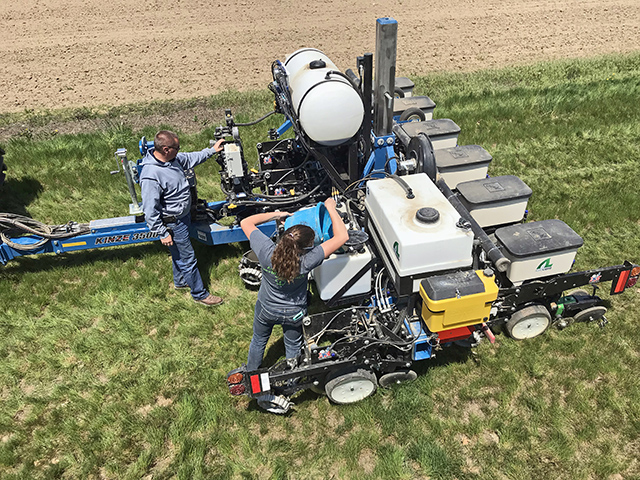In-Furrow Influence
Conquer Your Soybean Costs - In-Furrow Influence
Mike Starkey intends to make every dollar spent on soybean production count. That starts at planting with the right amount of nutrients in the right place.
Applying a blend of potassium, phosphorus, nitrogen and micronutrients in-furrow is the key to maximizing soybean production, the Brownsburg, Indiana, farmer explains. Each field gets a different rate based on soil tests.
"I'm putting products where they will be used for the crop year," Starkey says. "The return on investment is very good."
More and more soybean producers, such as Starkey, are putting fertilizer and crop-protection products in-furrow at planting, says Mike Staton, a Michigan State University (MSU) Extension soybean educator. This is partially in response to another recent trend of planting soybeans early -- before or at the same time as corn -- to boost yields.
Planting early isn't without risk, though. Cool, wet soil can delay emergence and lengthen exposure of seeds to soil-borne pathogens. In-furrow nutrients and crop-protection products such as fungicides can spur early growth and improve plant health.
P[L1] D[0x0] M[300x250] OOP[F] ADUNIT[] T[]
Staton says MSU researches in-furrow and near-seed fertilizer, and biological product placement. Results are mixed.
"Producers are always looking for ways to raise soybeans more intensively," he continues. "Margins are really tight. Farmers need to make sure the products and practices they're implementing allow them to maximize revenue potential.
"We've noticed some positive results with in-furrow fertilizer, but there are fewer winners than losers," Staton asserts.
The potential for a positive yield response from soybean starter fertilizer applied in-furrow or in a 2 x 2 band increases under certain conditions, according to MSU studies. These include when soil tests indicate phosphorus and potassium are below critical levels, and when cool or dry conditions occur after planting.
Applying fertilizer in-furrow isn't without risk, Staton explains. The potential of salt injury and nutrient toxicity to seeds and young plants exists. Damage could also occur to bacterial inoculant applied on seed.
Starkey contends he's had great success for 10 years applying three safe AgroLiquid products in-furrow when planting soybeans to promote early plant growth. These include Pro-Germinator (phosphate, nitrogen, potash and iron), Sure-K (nitrogen, phosphate, soluble potash) and Micro 500 (boron, zinc, manganese, iron and copper).
Though application rates change based on need, Starkey says it's not uncommon to use 2 gallons of Sure-K, 1 gallon of Pro-Germinator and 1 quart of Micro 500 per acre at a cost of $20 to $30 per acre. However, he says the 5- to 8-bushel-per-acre yield bump more than pays for it.
"We're watching every dollar and make sure we get something back for the investment," says Starkey, who farms with his brother, Jeff.
Stephanie Zelinko, AgroLiquid sales agronomy manager, has noticed a trend of more farmers using in-furrow starter fertilizers for many crops, including soybeans. She says Pro-Germinator has a good return-on-investment track record, but that may not be the case for every treatment.
"We (and the customer) won't win every time ... we're very transparent about that," Zelinko says. "The likelihood is very high, but there are a lot of interactions we can't control with Mother Nature."
There are many in-furrow fertilizer and crop-protection products available for soybeans, such as Priaxor fungicide by BASF, Keylate CoMo Classic by Stoller and NACHURS playmaKer, among others.
> Follow Matthew on Twitter at @progressivwilde.
[PF_1120]
(c) Copyright 2020 DTN, LLC. All rights reserved.



